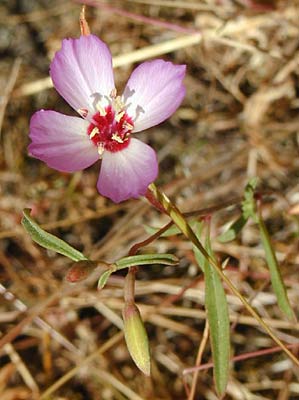Presidio clarkia facts for kids
Quick facts for kids Presidio clarkia |
|
|---|---|
 |
|
| Conservation status | |
| Scientific classification | |
| Genus: |
Clarkia
|
| Species: |
franciscana
|
Clarkia franciscana is a very special and rare type of wildflower. It's a small plant with pretty lavender-pink flowers that only grows in a few specific places in the San Francisco Bay Area in California, USA.
Contents
Description
The Presidio clarkia is an annual herb, which means it completes its entire life cycle in just one year. It grows from a seed, blooms, makes new seeds, and then the plant dies, leaving the seeds behind to start the cycle again the next year.
This little plant usually grows to be less than 40 centimeters tall, which is shorter than a standard ruler. Its stems are thin and stand up straight. The leaves are long and narrow, kind of shaped like a tiny spearhead, and are usually shorter than 2 inches.
The flowers of the Presidio clarkia are a lovely lavender-pink color. The petals are shaped a bit like a fan or a wedge, and they are darkest at the tips, getting lighter towards the middle. Right at the very base of each petal, there's a bright reddish-purple spot, like a little splash of paint. The flowers bloom from around May to July. When the flower buds are getting ready to open, they stand up straight. As the flower opens, the sepals (which are like little leaves that protect the bud) stay joined together on one side, while the petals open up from the other side. The flower has a bowl shape.
The Presidio clarkia is part of a plant family called the evening-primrose family (Onagraceae). Even though it's related to evening primroses, the Presidio clarkia has its own unique look and needs.
Where can you find it?
The Presidio clarkia is what scientists call "endemic" to the San Francisco Bay Area. This means it naturally lives only in this specific area and nowhere else in the whole world! It's like a plant that has its very own special hometown.
Within the San Francisco Bay Area, you can only find the Presidio clarkia in a few spots. The main places are the Presidio of San Francisco and some areas in the Oakland Hills.
What makes these places so special for the Presidio clarkia?
It's the soil! This plant has a very particular taste in dirt. It only grows in something called serpentine soil. Serpentine soil is a type of soil that comes from serpentine rocks. It's not like regular garden soil; it has different amounts of nutrients and minerals. Many other plants find it hard to grow in serpentine soil, but the Presidio clarkia is specially adapted to it. This helps it compete with other plants because not many others can survive in its preferred home.
The Presidio clarkia also likes to grow in open, sunny areas. It can be found in grassland and coastal scrub habitats where the sun can reach it easily and there aren't too many tall trees or bushes blocking the light.
Why is Presidio Clarkia so rare?
Because it's only found in a few small areas and needs a specific type of soil, it is considered a very rare plant. Its small population size and limited habitat make it vulnerable.
Scientists and nature helpers keep a close eye on the Presidio clarkia because it is listed as an endangered species. This means there is a risk that this plant could disappear forever if we don't protect it and its habitat.
The state of California listed the Presidio clarkia as endangered in 1978. The United States government also listed it as endangered under the federal Endangered Species Act in 1995. Being listed as endangered helps to protect the plant and its home. It means that it's against the law to pick or harm the Presidio clarkia.
Challenges
Even with protection, the Presidio clarkia faces some challenges that make it hard for it to survive and thrive.
One of the biggest problems is the loss and changes to its serpentine habitat. As cities grow and land is used for buildings or roads, the places where the Presidio clarkia lives can be destroyed or changed.
Another challenge comes from plants that are not native to the area, sometimes called invasive species or non-native plants. These plants can grow very quickly and take over the space and resources that the Presidio clarkia needs, like sunlight and water.
Things like people walking or riding bikes off of designated paths can accidentally trample and hurt the plants. Also, sometimes grass is mowed in areas where the Presidio clarkia grows before the plant has had a chance to make and drop its seeds for the next year.
Changes in the weather, like not getting enough rain, can also affect the Presidio clarkia. Since it's an annual plant, it relies on rain to help its seeds sprout and the plants grow each year. In dry years, fewer plants might grow.
Even things like air pollution can affect the soil and make it harder for the Presidio clarkia to grow.
Fun facts about Presidio Clarkia
- The genus name "Clarkia" is named after Captain William Clark, who was part of the famous Lewis and Clark Expedition that explored parts of North America a long, long time ago!
- It is a self-pollinating plant, which means it can make seeds using its own pollen. This is a helpful adaptation, especially when there aren't many other plants around.
- Sometimes, in very dry years, the seeds of the Presidio clarkia might stay dormant in the soil and wait for better conditions before they sprout.


